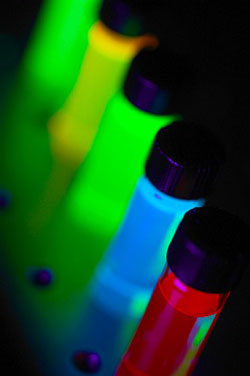| Posted: Sep 29, 2010 | |
Crystal engineering: Composition of functions |
|
| (Nanowerk News) The electronic bandgap is an intrinsic property of semiconductors that to a large extent determines their optical properties, such as their emission color. Having the ability to adjust the bandgap can be extremely useful for developing semiconductor nanocrystals with novel properties and applications in optoelectronics, photovoltaics and biological imaging. | |
| Several approaches have been used to tune the bandgap of a semiconductor. One common approach involves altering the crystal size, and many groups have already demonstrated this technique in experiments. The bad news is that in many applications, semiconductor nanocrystals must be very small in order to produce the desired properties. | |
 Fig. 1: The emission color of Zn–Cd–Se nanocrystals, shown here dispersed in solution, can be tuned by adjusting their composition. Another approach is to change the crystal composition. This method usually involves alloying together two semiconductors with different bandgap energies, but research in this area is in its infancy. Ming-Yong Han and co-workers from the A*STAR Institute of Materials Research and Engineering in Singapore have now demonstrated ("Composition-Tunable Alloyed Semiconductor Nanocrystals") an example of composition-based bandgap engineering using an alloy of cadmium selenide (CdSe) and zinc selenide (ZnSe). By controlling the proportions of these two compounds, the researchers produced high-quality nanocrystals that exhibit interesting optical properties not observed in the parent semiconductors. To make the nanocrystals, Han and his colleagues used a method called high-temperature colloidal synthesis. This technique produces nanocrystals with high uniformity and has been used by the researchers in the past to prepare zinc cadmium sulfide nanocrystals. Tuning of Zn–Cd–Se alloy composition simply involved varying the ratio of the zinc and cadmium precursors. In contrast to size-tuning, this approach produces highly stable nanocrystals because the crystals remain relatively large. With increasing zinc content, the nanocrystals display a systematic 'blue shift' in the bandgap, consistent with the wider bandgap of ZnSe relative to that of CdSe. Certain compositions of Zn–Cd–Se nanocrystals have been shown to emit blue light with exceptional efficiency — a property shown by neither CdSe nor ZnSe. Blue emission could be particularly useful in short-wavelength optoelectronic applications and in white-light generation. |
|
| Although the study of compositional engineering for producing alloy nanocrystals is still in its early days, Han and his team are anticipating more novel alloy nanocrystals in the near future. "The alloying of two semiconductors at the nanoscale provides a new scheme for bandgap engineering of semiconductor nanocrystals," says Han. "It is an effective technique in the design of new nanomaterials, and the high-quality composition-tunable alloyed semiconductor nanocrystals offer us an opportunity to investigate quantum-composition effects." |
| Source: A*STAR |
